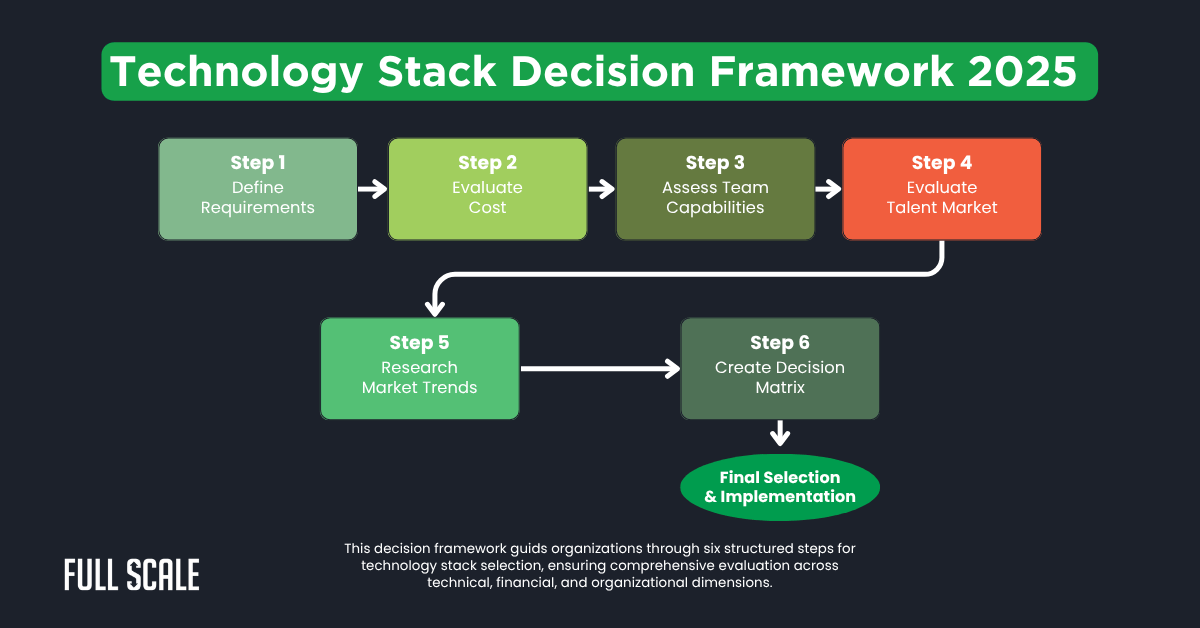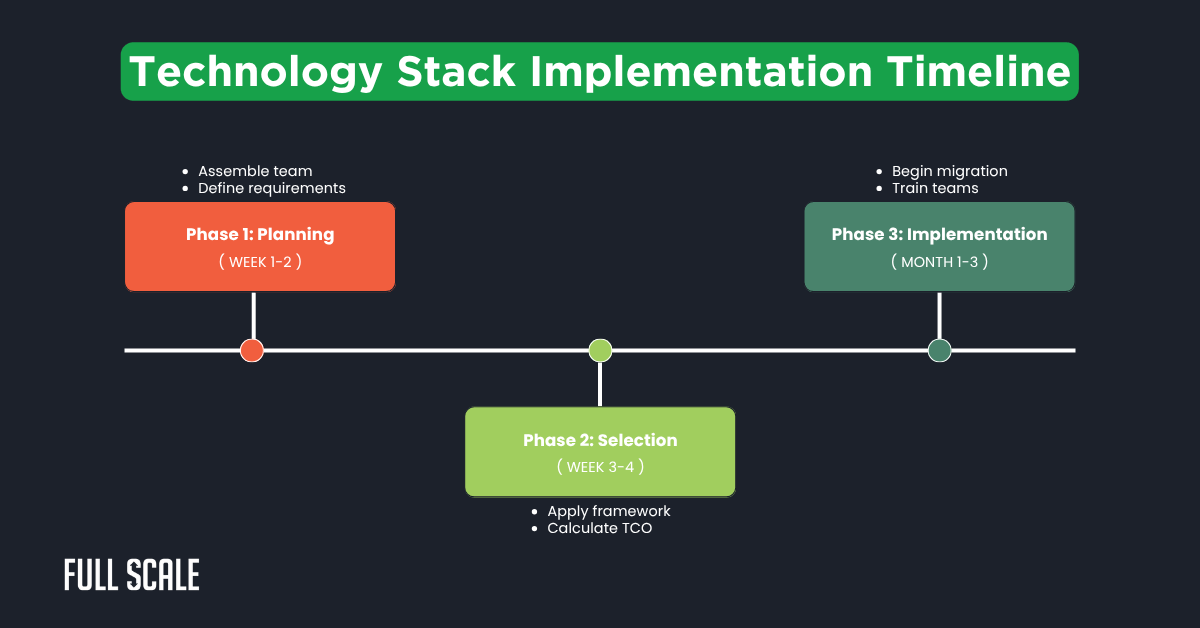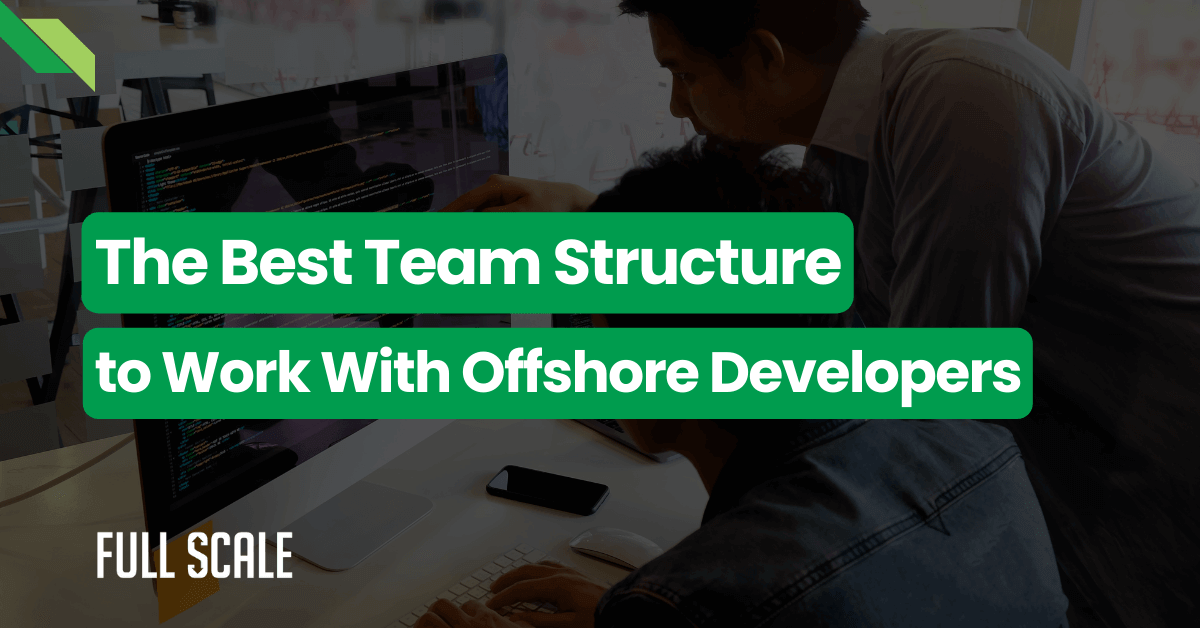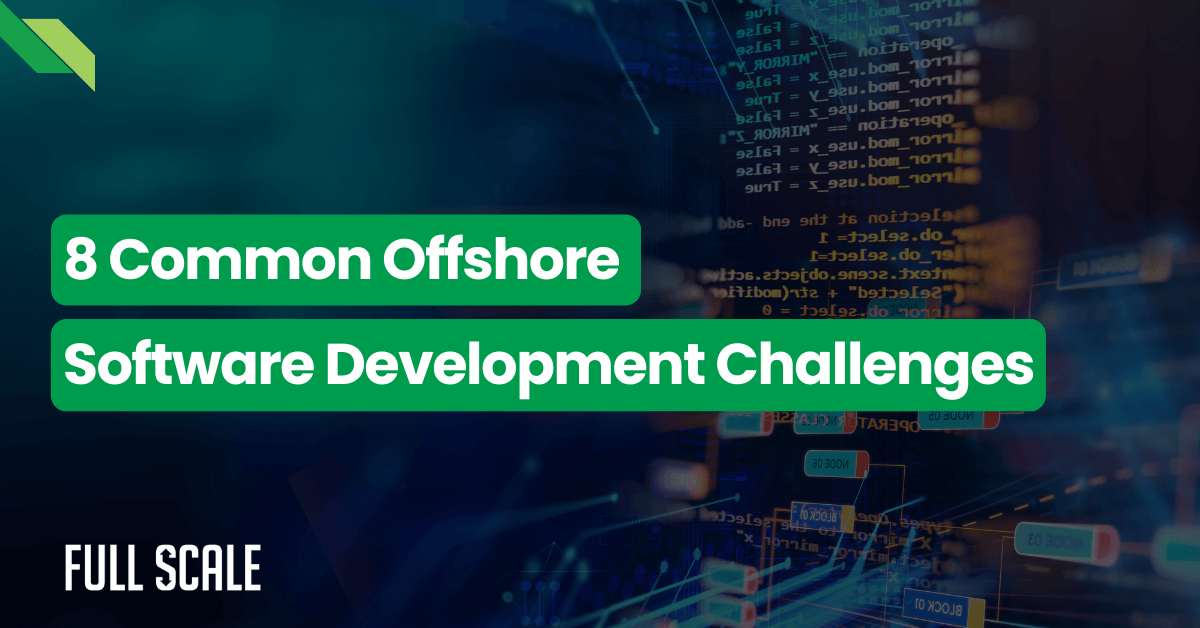Last Updated on 2025-08-26
Choosing the wrong technology stack costs companies $2.3 million on average, with 31.1% of software projects canceled before completion and 52.7% exceeding budgets by 189%. Recent Stack Overflow data shows 76% of developers are using or planning to use AI tools in 2025, making technology stack selection more critical than ever.
This comprehensive guide shows CTOs, product leaders, and finance directors how to choose a technology stack in 2025 using proven frameworks.
Learning how to choose a technology stack in 2025 requires a systematic evaluation across technical, financial, and organizational factors.
How to Choose a Technology Stack in 2025: Key Factors
How to choose a technology stack in 2025 involves six critical factors:
- Project requirements
- Scalability needs
- Team expertise
- Budget constraints
- Talent availability
- Maintenance costs.
Follow this framework: assess business goals, analyze technical requirements, evaluate costs, review team capabilities, research market trends, and create a weighted decision matrix.
Engineering leaders face pressure to scale rapidly while maintaining quality. Product managers need faster time-to-market without sacrificing performance. Finance directors demand clear ROI from technology investments.
Technology Stack 2025: Current Landscape
The technology landscape evolves rapidly with AI integration and cloud-native architectures reshaping development priorities. Understanding current trends helps organizations make informed technology stack decisions.
What Makes the Best Technology Stack?
A technology stack combines frontend frameworks, backend services, databases, and infrastructure. Modern technology stack 2025 trends include AI integration, cloud-native architectures, and edge computing capabilities.
Organizations that understand how to choose a technology stack in 2025 systematically evaluate stacks using technology stack selection criteria like performance, scalability, and developer productivity. The best technology stack balances technical requirements with business objectives and team capabilities.
Technology Stack Selection Criteria Comparison
The following table shows how to choose a technology stack option across key dimensions:
| Criteria | Weight | React/Node.js | Python/Django | Java/Spring | Scoring Method |
| Development Speed | 25% | 9/10 | 7/10 | 6/10 | Feature velocity |
| Scalability | 30% | 8/10 | 8/10 | 9/10 | Load capacity |
| Team Expertise | 20% | 9/10 | 7/10 | 8/10 | Skill availability |
| Total Costs | 15% | 8/10 | 9/10 | 7/10 | TCO analysis |
| Talent Pool | 10% | 10/10 | 8/10 | 8/10 | Developer count |
| Weighted Score | 100% | 8.45 | 7.65 | 7.70 | Final ranking |
This technology stack comparison checklist helps organizations make objective decisions using quantified criteria.
Technology Stack Decision Framework
The technology stack decision process follows six structured steps. This visual framework shows how to choose a technology stack in 2025 systematically:

Step 1: Define Requirements
Business requirements determine technology stack selection success. Map functional needs including authentication, payments, and analytics. Document non-functional requirements like performance benchmarks and security protocols.
Growth projections guide scalability technology stack architecture decisions. Include specific metrics for response times, user loads, and data volumes.
Step 2: How to Evaluate Technology Stack Costs
The technology stack total cost of ownership includes licensing, infrastructure, development, and maintenance expenses. Use this framework:
| Cost Component | Year 1 | Year 2 | Year 3 | Percentage |
| Licenses | $45,000 | $52,000 | $60,000 | 13% |
| Infrastructure | $72,000 | $95,000 | $125,000 | 24% |
| Development | $240,000 | $180,000 | $200,000 | 51% |
| Maintenance | $36,000 | $48,000 | $65,000 | 12% |
| Total | $393,000 | $375,000 | $450,000 | 100% |
Technology stack ROI analysis should include efficiency gains, faster time-to-market, and operational savings.
Step 3: Assess Team Capabilities
Current skill inventory reveals gaps in programming languages and frameworks. Learning curve analysis estimates training time and costs for new technologies.
Cost-effective technology stack choices leverage existing team expertise while supporting growth objectives. Budget $5,000-$15,000 per developer for technology stack training requirements.
Step 4: Evaluate Talent Market
Technology stack developer availability in 2025 varies significantly by technology choice. JavaScript offers the largest talent pool with 13.8 million developers globally.
| Technology | Developers | Avg Salary | Hiring Speed | Remote Work |
| JavaScript | 13.8M | $95,000 | Fast | Excellent |
| Python | 10.1M | $105,000 | Medium | Excellent |
| Java | 9.6M | $98,000 | Fast | Good |
| Go | 1.8M | $115,000 | Slow | Excellent |
Technology stack talent availability directly impacts hiring timelines and project success rates.
Enterprise Technology Stack Best Practices
Enterprise applications require proven architectural patterns that support scalability and maintainability. These best practices ensure long-term technology stack success across large organizations.
Scalable Technology Stack Architecture Patterns
Enterprise applications require proven, scalable technology stack architecture patterns. Microservices enable independent scaling and team autonomy. Cloud-native patterns support dynamic resource allocation.
Key Architecture Decisions:
- Horizontal Scaling: Add servers for increased capacity
- Vertical Scaling: Improve individual server performance
- Microservices: Independent component development and deployment
- API-First: Standardized integration patterns
Technology Stack for Remote Teams
Remote development requires specific technology stack considerations. Cloud-native technology stack 2025 solutions support distributed teams effectively.
Remote Team Requirements:
- Collaboration Tools: Integrated development environments
- CI/CD Pipelines: Automated testing and deployment
- Monitoring: Real-time performance tracking
- Security: VPN and access controls
Industry-Specific Technology Stack Selection
Different industries have unique compliance requirements and operational challenges that influence technology choices. Tailored technology stack approaches ensure regulatory compliance and optimal performance.
FinTech Technology Stack Selection
Financial services need specialized technology stack approaches. FinTech technology stack selection prioritizes security, compliance, and transaction processing.
Critical Requirements:
- PCI DSS compliance for payment processing
- Real-time transaction capabilities
- Regulatory reporting and audit trails
- Multi-region deployment for compliance
Healthcare Technology Stack Compliance
Healthcare applications require HIPAA-compliant technology stacks. Healthcare technology stack compliance includes data encryption, access controls, and audit logging.
E-commerce Technology Stack Scalability
E-commerce platforms need high-performance technology stacks. E-commerce technology stack scalability handles peak traffic during sales events and seasonal spikes.
Technology Stack Implementation Timeline
Successful technology stack implementation requires structured phases and clear milestones. This visual timeline shows the key stages and activities for technology stack migration planning:

Phase 1: Planning (Weeks 1-2)
- Assemble an evaluation team across departments
- Define business and technical requirements
- Conduct a technology stack comparison 2025 analysis
- Create a technology stack pros and cons matrix
Phase 2: Selection (Weeks 3-4)
- Apply the technology stack decision framework
- Calculate the technology stack’s total cost of ownership
- Evaluate technology stack developer availability in 2025
- Make the final selection using weighted criteria
Phase 3: Implementation (Months 1-3)
- Begin technology stack migration planning
- Start team training on selected technologies
- Implement a pilot project for validation
- Monitor performance against success metrics
Modern Technology Stack Architecture Trends
Emerging technologies like AI integration and edge computing transform traditional application architectures. Organizations must evaluate these trends for competitive advantage and future readiness.
AI-First Technology Stack 2025
AI integration transforms application architecture. AI-first technology stack 2025 includes machine learning frameworks, model serving infrastructure, and automated decision systems.
Popular AI Stack Components:
- Python + TensorFlow: Model development
- FastAPI: High-performance APIs
- Docker: Containerized deployment
- Kubernetes: Orchestration and scaling
Cloud Native Technology Stack 2025
Cloud-native approaches reduce infrastructure costs by 20-40%. Modern cloud native technology stack 2025 includes containers, orchestration, and serverless computing.
Rapid Development Technology Stack
Organizations prioritize speed with rapid development technology stack choices. These enable faster MVP development and shorter iteration cycles.
Technology Stack Migration Planning
Legacy system transitions require careful planning to minimize business disruption and technical risks. Strategic migration approaches ensure successful technology stack adoption and team alignment.
Signs You Need a New Technology Stack
Organizations should evaluate new technology stacks when experiencing performance or scaling challenges. Understanding how to choose a technology stack in 2025 becomes critical when current solutions fail to meet business requirements:
- Performance Issues: Response times exceed user expectations
- Scaling Problems: Unable to handle growth requirements
- Development Delays: Feature delivery slows significantly
- High Maintenance Costs: Support expenses increase dramatically
- Talent Challenges: Difficulty hiring qualified developers
Migration Strategy Framework
Successful technology stack migration planning includes risk assessment, phased implementation, and rollback procedures. Teams learning how to choose a technology stack in 2025 should plan 6-12 months for enterprise migrations. This timeline ensures proper evaluation and implementation of new technology decisions.
Technology Stack Evaluation Criteria Checklist
Use this comprehensive checklist when learning how to choose a technology stack in 2025 for your organization. This framework addresses every aspect of how to choose a technology stack in 2025 effectively:
Technology Stack Selection Framework
Successful technology stack selection in 2025 requires systematic evaluation across technical, financial, and organizational dimensions. Organizations that follow a structured on how to choose a technology stack in 2025 achieve better outcomes and competitive advantages.
The technology stack decision framework provides objective comparison methods and stakeholder alignment. Success depends on clear requirements, comprehensive evaluation, and phased implementation approaches.
Next Steps Action Plan
This visual roadmap shows the structured approach to implementing technology stack decisions effectively:

Week 1: Assemble evaluation team and define requirements using technology stack selection criteria
Month 1: Complete technology stack comparison using decision matrix and TCO analysis
Quarter 1: Execute pilot implementation and team training programs
Expert Technology Stack Consultation
Complex technology decisions benefit from professional expertise. Organizations seeking guidance on how to choose technology stack in 2025 can accelerate decision-making with expert consultation. Full Scale provides technology stack consultation, development team augmentation, and implementation services.
Our global team offers expertise across modern technology stacks including cloud-native architectures, AI integration, and scalable applications. We help organizations make informed decisions aligned with business objectives.
Get Expert Technology Stack Consultation
FAQs: How to Choose Technology Stack in 2025
Is SQL a tech stack?
SQL is a database query language, not a complete technology stack. Technology stacks include multiple layers:
- Frontend frameworks (React, Angular)
- Backend services (Node.js, Python)
- Database systems (PostgreSQL, MongoDB)
- Infrastructure components (AWS, Docker)
SQL serves as the database component within larger technology stack architectures.
Is Python a technology stack?
Python is a programming language that forms part of technology stacks. Complete Python technology stack 2025 solutions include:
- Framework: Django or Flask for web development
- Database: PostgreSQL or MongoDB for data storage
- Infrastructure: Docker containers and cloud deployment
- Frontend: React or Vue.js for user interfaces
Python enables both backend development and an AI-first technology stack 2025 capabilities with machine learning frameworks.
What is an example of a software stack?
MEAN stack exemplifies modern software stacks for rapid development technology stack choices:
- MongoDB: Document database for flexible data storage
- Express.js: Backend framework for API development
- Angular: Frontend framework for user interfaces
- Node.js: JavaScript runtime environment
This technology stack comparison shows how components work together for full-stack JavaScript development across enterprise technology stack best practices.
How does Full Scale help with technology stack selection?
Full Scale provides comprehensive technology stack consultation services, including:
- Expert Evaluation: How to choose a technology stack in 2025 using proven frameworks
- Cost Analysis: Technology stack total cost of ownership calculations
- Team Assessment: Technology stack developer availability 2025 analysis
- Implementation Planning: Technology stack migration planning and execution
Our experienced engineers help organizations make informed technology stack selection decisions aligned with business objectives and scalable technology stack architecture requirements.
What are the most important technology stack selection criteria?
The best technology stack evaluation focuses on six critical technology stack selection criteria:
- Performance Requirements: Response times and scalability needs
- Team Expertise: Current skills and technology stack training requirements
- Budget Constraints: Technology stack ROI analysis and total costs
- Market Availability: Technology stack talent availability for hiring
- Business Timeline: Time-to-market and development speed needs
Long-term Maintenance: Support costs and upgrade complexity

Matt Watson is a serial tech entrepreneur who has started four companies and had a nine-figure exit. He was the founder and CTO of VinSolutions, the #1 CRM software used in today’s automotive industry. He has over twenty years of experience working as a tech CTO and building cutting-edge SaaS solutions.
As the CEO of Full Scale, he has helped over 100 tech companies build their software services and development teams. Full Scale specializes in helping tech companies grow by augmenting their in-house teams with software development talent from the Philippines.
Matt hosts Startup Hustle, a top podcast about entrepreneurship with over 6 million downloads. He has a wealth of knowledge about startups and business from his personal experience and from interviewing hundreds of other entrepreneurs.




